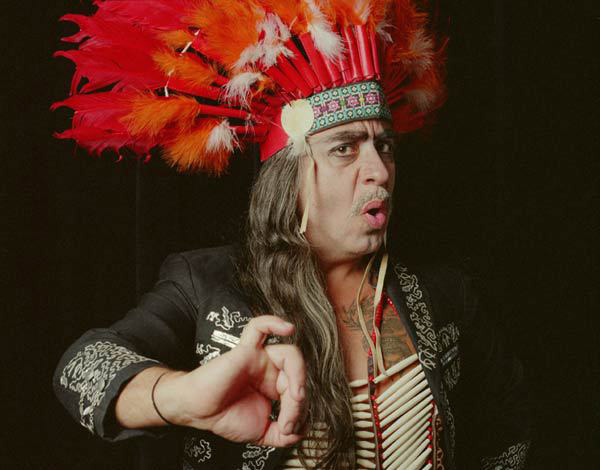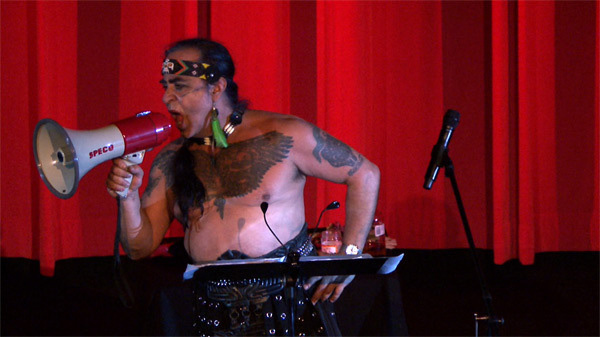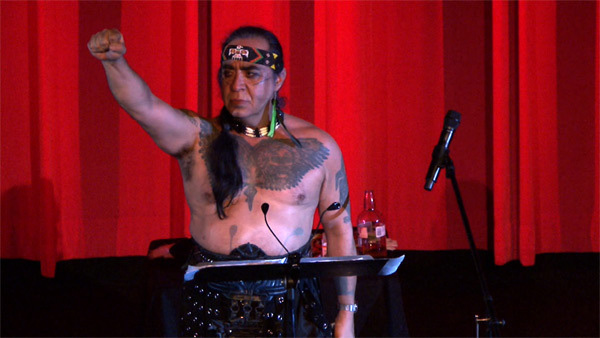Reports from a Strange Democracy: Guillermo Gómez-Peña
by Audrey Chan

Guillermo Gómez-Peña. All images courtesy of the Hammer Museum, Los Angeles.
The setup: Guillermo Gómez-Peña enters from stage right costumed in his signature “mariachi drag” walking with a stilted vaquero-dama strut, a boot on his right foot and stiletto pump on his left. His simple props for the evening consist of a table set with a megaphone, mineral water, a half-empty bottle of whiskey, a jar of salsa, sunglasses, a feather headdress, and a tall can of Right Guard men’s spray deodorant. Picking up the can of deodorant with intentionality, he performs a shamanic rite of invocation to bless the cardinal directions. Each 90-degree turn is punctuated by a shout—¡Norte! ¡Sur! ¡Este! ¡Oeste!—and a spray of artificial musk hissing into the stale air of the auditorium, defiling our lungs as we choke on our laughter.
Over the next two hours he presents a series of verbally audacious monologues from center stage, delivered in a throaty Spanglish patois and punctuated tenderly with pet names for the audience like carnal and locos y locas. He confronts the racism of nativist Tea Party zealots and the 24-hour news cycle pundits Glenn Beck and Lou Dobbs, whose positions on immigration he says are based on a misguided notion that it is possible to remain a “monolingual member of a multilingual community.” He meditates on the powerful and complicated symbolism of President Barack Obama, who is at once an “intellectual mulatto with a Muslim name,” a Nobel Peace Prize winner overseeing three wars, and an object of both fervent hope and bigotry. He maps out the “strange democracy” we live in today and charts the misadventures of an artist who has spent his life crossing its contested cultural and psychic borders.
The performance of Strange Democracy: Border Wars at the Hammer Museum this spring was a homecoming for Gómez-Peña, who made his first journey north from Mexico City to Los Angeles as a young art student in 1978.1But the notion of a “homecoming” is likely bittersweet for someone who has made a career of considering “home” as a constructed and often dangerous idea, one that has been used to justify racist policies and the militarization of borders, particularly that between the US and Mexico.
Gómez-Peña’s career has spanned the culture wars, NAFTA, 9/11, and the emergence of post-9/11 America, as well as the rise of corporate-populist online media channels that have both inflamed and displaced civic discourse. He is of a generation of artists known for directly and explosively confronting race, gender, and class—ethical and humanist issues of identity that merit as much urgent attention today as they did in the 1980s and 1990s, when they formed a larger part of the national conversation.2The artists coming of age today were in their infancy during the Reagan-era battles over NEA funding for the arts in which Gómez-Peña fought and bled with conviction. (I dare to speak on behalf of today’s generation by admitting that federal grants for artists seems like a far-gone pipe dream in a time marked by economic collapse, terror politics, and a perpetual state of emergency.) These artists (such as Karen Finley, Ron Athey, and James Luna, to name just a few) used, and continue to use, their bodies and an audience’s psyche as a site of enacting social change. With regard to radicalism, the landscape of performance art—and, it could be said, the art world in general—has gradually shifted away from practices of direct confrontation toward stances that are characterized more by cool detachment and coded references; the aesthetics of revolution drained of a movement’s urgency. Strange Democracy felt like a plea for the repoliticization of art and artists in a period threatened by dangerous complacency among cultural workers who have become resigned to both the political impotence within the commercial gallery structure and the widespread defunding of critical and intellectual culture in America. The question remains whether such pleas can still be heard.

Guillermo Gómez-Peña, Strange Democracy: Border Wars, 2011. Performance at the Hammer Museum, April 5, 2011.
Inspired by religious ritual, S&M culture, experimental theater, pop culture, and other contested sites of spectacle, Gómez-Peña’s performances have long involved inviting audience members to use the performer as a live medium to open psychic wounds and release buried racist thoughts, forbidden desires, even self-loathing, which has, on rare occasions, resulted in physical harm to the performer.3The goal of these performances was catharsis through metaphor; “metaphor” coming from the Greek meta (between) and pherō (“to bear” or “to carry”), an apt description for an artistic practice rooted in the unstable terrain of the interstitial.4Now he invited us to figuratively stick our fingers in his psychic wounds, to laugh along with him at his life’s follies. As the evening progressed, he shed pieces of his costume so that by the final act he stood bare chested, his bleeding heart on full display.
The only difference between a madman and a performance artist is that a performance artist has an audience. —Guillermo Gómez-Peña5
Gómez-Peña’s desire to read an audience (their demographics, proclivities, and attitudes) for potential material shapes his writing and performance strategies. For an artist who has performed internationally on Native American reservations, college campuses in middle America, remote European villages, Zapatista community centers, and, yes, highbrow art institutions, the shape and content of a given performance could be seen as the artist’s diagnosis for a perceived malady to be treated. So what psychic change did he think the Hammer audience needed? He addressed his direct first-person appeal to an audience of left-leaning art sympathizers (including colleagues and admirers) living in Los Angeles, the definition of a modern-day melting pot metropolis. We were a group of individuals as likely to speak out against SB 1070—Arizona’s controversial anti–illegal immigration legislative measure—as we were to pull out a mobile device to check the “status” of our “friendships” on Facebook.6We were a principled but easily distracted contingent.

Guillermo Gómez-Peña, Strange Democracy: Border Wars, 2011. Performance at the Hammer Museum, April 5, 2011.
My psyche abandoned me once it discovered I am a Wikipedia entry. —Guillermo Gómez-Peña
The specter of Gómez-Peña’s legacy as a performance artist hung over the evening. He meditated on his own mortality, “My age weighs on my shoulders like … like a towering chihuahua. My legs are exhausted from walking nonstop across the continent; my liver is weak, and so is my memory.” It is possible that we were witnessing an artist, famous for desacralizing holy icons, deconstructing his own mythos and exorcising his doubts about the past, present, and future. Gómez-Peña’s practice has been the art of creative opposition. The artist has measured his own efficacy by his ability to generate controversy and provoke shock in the public; it is a measure of his ability to provoke catharsis in an audience, to purge cultural demons, to provoke change on a microlevel that could reverberate exponentially in the outside world. He has also acknowledged that shocking behavior today has become so fully co-opted by mainstream pop culture that it is simply one more form of crude entertainment. Fortunately or unfortunately, people aren’t that offended by “shock” anymore.
Naming my antisocial behavior “art” has saved me from the jaws of the police, the border patrol, and the pinche IRS. —Guillermo Gómez-Peña